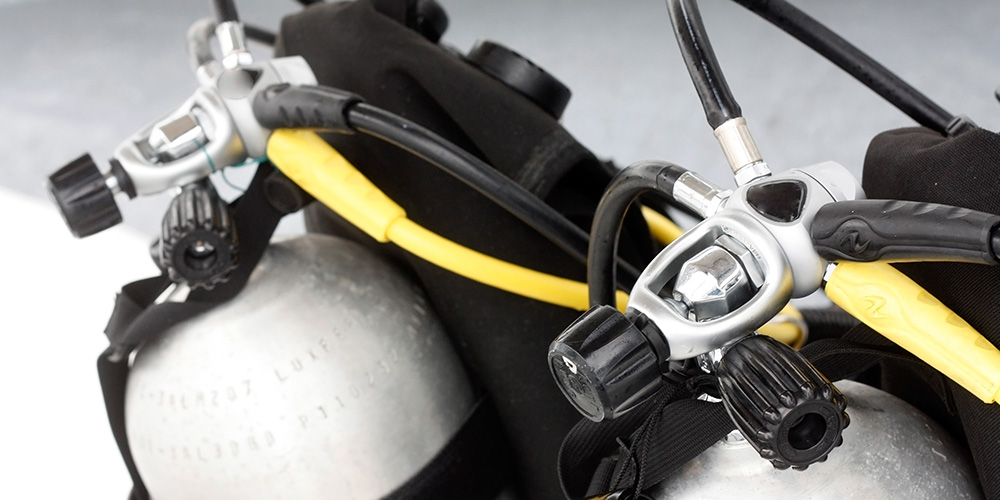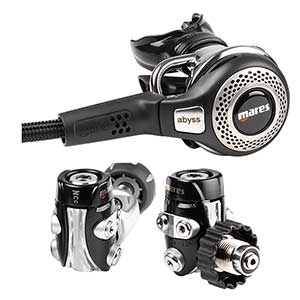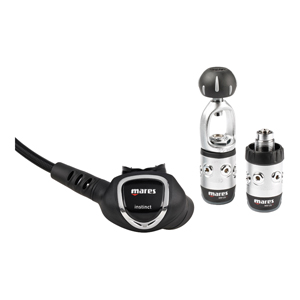

The Abyss 52 second stage regulator comes with a compact high performance DIN first stage MR52 with 2 high-pressure ports and 4 low-pressure ports.
Diving regulators enable divers to breathe underwater, at depth, from a tank of compressed air. SCUBA (Self-Contained Underwater Breathing Apparatus) regulators consist of two components: a first stage regulator and a second stage regulator. The first stage regulator connects to the tank and its purpose is to reduce the high-pressure air from the tank to an intermediate pressure that the diver can breathe. The second stage regulator fits to the diver's mouth and it is through this component that he or she breathes. Most SCUBA setups include an additional second stage regulator referred to as an “octopus” which serves as a backup to a diver's main or primary second stage regulator. Other important functions of the first stage regulator include supplying air to a pressure gauge, BCD or to a dry suit. Consider the following when selecting a first or second stage regulator:
Types of First Stage Regulators: DIN and Yoke
There are two different styles of first stage regulators: DIN (Deutsche Industrie Norm) and yoke. A DIN first stage regulators screw into the tank and includes an O-ring that seals the connection to the tank. DIN first stage regulators are used more often for technical diving. Yoke-style first stage regulators clamp to the tank with the seal provided by a rubber O-ring that surrounds the orifice of the tank valve itself—so if you are renting tanks, make sure the O-ring isn’t rotted. Yoke style regulators are used more commonly in recreational diving.
Other Functions of First Stage Regulators
In addition to supplying air to a divers primary second-stage regulator and to an octopus, first stage regulators include various ports that can be connected to hoses that supply air to other apparatus such as a BCD (Buoyancy Compensator Device), tank pressure gauge or for example, to a dry suit. So when shopping for a first stage regulator, make sure it includes the ports you need to set up your diving kit the way you want.

The Instinct 12S second stage regulator's ergonomical and minimalist design sits naturally in the diver’s mouth and keeps the field of vision clear.
Features to Look for in Second Stage Regulators
Second stage regulators should fit comfortably in your mouth to reduce jaw fatigue. A regulator delivers air at the right pressure no matter your depth. An advanced feature on some regulators allows divers to manually adjust the air pressure to fine-tune breathing and prevent free-flow of air. Regulators also include a purge valve to get rid of moisture build-up and to expel unwanted water that may enter the device. The Mares 12S Regulator is designed with an oversized purge button so it’s easy to purge water even if you’re wearing cumbersome dive gloves. Ergonomic models like the Mares Instinct 12S Regulator include exhaust valves that channel exhaled air downwards so the bubbles will not block your field of view.
What are the Alternate (Octopus) Second Stage Functions
An mentioned above, a diver's octopus is also a second stage regulator that acts as a backup breathing apparatus in case the primary second stage regulator fails or if your dive buddy needs emergency air. Most octopi are brightly colored so you can spot and access them if assisting another diver is necessary. Mares Octopus MV regulator is symmetrical making it easy for someone to use on the right or left. Most Buoyancy Compensator Devices (BCDs) have a strap to keep the octopus close by.